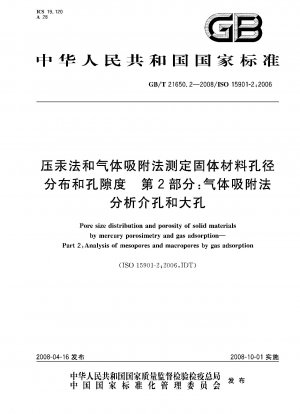GB/T 21650.2-2008
Pore size distribution and porosity of solid materials by mercury porosimetry and gas adsorption.Part 2: Analysis of mesopores and macropores by gas adsorption (English Version)
- Standard No.
- GB/T 21650.2-2008
- Language
- Chinese, Available in English version
- Release Date
- 2008
- Published By
- General Administration of Quality Supervision, Inspection and Quarantine of the People‘s Republic of China
- Latest
- GB/T 21650.2-2008
- Scope
- This part of GB/T 21650 specifies a method for the determination of porosity and pore size distribution using the gas adsorption method, which is used for comparative rather than absolute testing. This method is limited to the determination of gas adsorption per unit mass of sample at a constant controlled temperature. This section does not specify the use of a specific adsorbent gas, but nitrogen is the most commonly used adsorbent gas, and liquid nitrogen temperature is the most commonly used analysis temperature. Other adsorbed gases are sometimes used, including oxygen, carbon dioxide, and chlorine. Other analysis temperatures are also used, including liquid oxygen and solid carbon dioxide temperatures. When using nitrogen at liquid nitrogen temperature for adsorption, the basic method of this method is to measure the variation of nitrogen adsorption with its relative pressure at 77K. This part specifies the calculation method for the distribution of mesopore size from 2nm to 50nm and the distribution of macropore size up to 100nm. Generally speaking, nitrogen adsorption is most suitable for the determination of pores with a width in the range of about 0.4 nm to 50 nm. Thanks to advances in temperature control and pressure measurement techniques, it is now possible to measure larger pore widths. The methods specified in this standard are applicable to a wide range of porous materials. Even the pore structure of some materials can sometimes be affected by pretreatment or cooling regimes. This standard specifies two types of methods for determining the amount of gas adsorbed: - measurement of the amount of gas reduced from the gas phase (i.e. gas volume method); - measurement of the amount of gas obtained by the adsorbent (i.e. gravimetric method for direct measurement of mass gain) . For practical applications, static or dynamic techniques can be used to determine gas adsorption. To calculate pore volume and pore size distributions from isotherms, one or more mathematical models need to be employed, which requires simplifying the underlying assumptions.
GB/T 21650.2-2008 Referenced Document
- GB 3101 Quantities and units--General principles
- GB/T 19587 Determination of the specific surface area of solids by gas adsorption using the BET method*, 2017-09-29 Update
- ISO 8213 Chemical products for industrial use; Sampling techniques; Solid chemical products in the form of particles varying from powders to coarse lumps
- ISO 9276-1 Representation of results of particle size analysis — Part 1: Graphical representation TECHNICAL CORRIGENDUM 1
GB/T 21650.2-2008 history
- 2008 GB/T 21650.2-2008 Pore size distribution and porosity of solid materials by mercury porosimetry and gas adsorption.Part 2: Analysis of mesopores and macropores by gas adsorption

GB/T 21650.2-2008 -All Parts
GB/T 21650.1-2008 Pore size distribution and porosity of solid materials by mercury porosimetry and gas adsorption.Part 1: Mercury porosimetry
GB/T 21650.2-2008 Pore size distribution and porosity of solid materials by mercury porosimetry and gas adsorption.Part 2: Analysis of mesopores and macropores by gas adsorption
GB/T 21650.3-2011 Pore size distribution and porosity of solid materials by mercury porosimetry and gas adsorption.Part 3:Analysis of micropores by gas adsorption